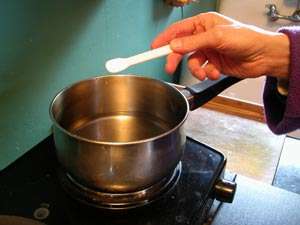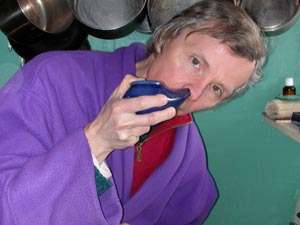

or using the Neti Pot
This article is also available in PDF format.
|
We have been using the neti-pot for many years now, and we are very happy with it. We use it on a
regular basis as a preventive method, and actively when a cold strikes.
The real advantage in using it for a cold is that the cold never has a
chance to enter the nose. No stuffy, running, or inflamed noses.
Breathing clear all night without any medicines! Considering that our
environment is full of pollutants, both in the house as well as outside,
using the neti-pot improves our health. Introduction to Jala
Neti Jala Neti, or nasal cleansing using warm salty water, is a very ancient technique which has been passed on for thousands of years by the Yogis for both physical as well as deeper spiritual benefits. Now is possibly a time of the greatest need for such a practice by modern people. With the ever increasing incidence of respiratory illnesses such as asthma, allergies, hay fever, sinusitis, colds, influenzas, etc, as well as the rapid degeneration of spiritual consciousness in some sections of society, the practice of Jala Neti could serve as a panacea for helping to improve the lives of many people. Neti is a practice which is very beneficial to the cleanliness of the eyes, ears, nose, throat, lungs, as well as the thinking processes. There are more than 7 different methods and stages of doing Neti, however we will only be describing the essential beginners ones here which may easily be learned from any yoga teacher experienced in them. Some neti pots on the market:
|
|
Summary of the Technique A special Neti Pot is filled with warm, slightly
salted water. Do not use chlorinated tap water, use pure water, distilled
is always a safe bet. Lean forward over the sink, head half down and turned
to the side. The nose cone is placed against one nostril and the position
of the head and pot is adjusted to allow the water to flow out of the other
nostril. Only breathe through the mouth whilst the water is flowing through
the nasal passages. After half a pot has flowed in one direction, change
sides, so the water flow is reversed. You can do a second pot if desired.
When the water in the pot is finished, the nose must be dried well. Take
your time, as the water will come down by itself in a minute or two. "Swimming
pool head" may happen before you get the hang of it, and learn just
how to hold your head correctly. Also plain water or water that is not quite
salty enough may cause that reaction. The Benefits of Jala Neti Neti removes all the dirt
and bacteria-filled mucus from within the nose. |
|
Anatomy of Jala Neti
Practice For those who
may not have a good idea of the internal workings of the nasal cavities,
it may seem like a stupid or dangerous thing to pour warm salty water
through one's nose! But when examined with an open mind and a clear
picture of the physiological structures involved, fear and
misunderstanding can be cleared up. Although there are many factors
which govern our body's overall condition, correct nasal function is of
primary importance to good health.
Details of the Method, stage 1 Nasal cleansing can be performed over a sink, a
bowl on a table, in the shower or outside. |
 We use 1 cup of distilled water and 1/4 teaspoon of sea salt.
Pouring half of the warm salt water into the neti pot for the first rinse. |
1. First fill the Neti Pot with warm water of a temperature suitable for pouring in the nose. Not too hot or cold. Test it in your mouth to really tell if it is right. Pure water is best if available. Mix in salt to the proportion of one teaspoon for half a liter of water. In our 400 ml pot this would be a bit less than one level normal sized teaspoon. Sea salt is best if available. See paragraph following "Recommended Salts for Use in Jala Neti". Mix the salt thoroughly. Taste the water and gargle or spit, just to be sure of the correct mix and temperature. It will not be as salty as sea water. Adjust if not correct. After several attempts you will be able to recognize the correct mixture. |
 Insert into the first nostril.
Tilt the head.
Hold the head horizontal and move slightly around to get the water flowing up the nostril and out the other nostril. |
2.
Now slowly bend forward from the waist so that the tip of the nose is the
lowest point of the head, and then tilt/roll the head to the right, so that
the left nostril is now the lowest point of the nose. |
|
3. Tip the head slightly forward again, blow out
gently through both nostrils to clear water and mucus from the nose. Drying the Nose Drying the nose is important. People with high
blood pressure should be careful, if dizziness results when blowing to
clear the nose, only do it standing upright. Pay Attention To: - the angle of the head and/or pot is incorrect Recommended Frequency of Neti Practice For general nasal cleanliness, once or twice a
day is usually sufficient. Nasal Cleansing is best practiced first thing
in the morning to clear out the night's grogginess and prepare the body
for the day's breathing activities. However, if you live or work in a
dusty or polluted environment where the nostrils have an increased load
of filtering, a good second occasion is upon returning from such work.
Neti should always be done before rather than after meals. It can be
done up to a maximum of 4 times a day for therapeutic applications: upon
waking before breakfast, before lunch, before dinner, before bed; but
only upon qualified advice. In the case of a cold, 3 - 4 times a day
will give great relief, providing the nose is well dried and this
frequency does not induce nose bleeds. Limitations - Persons who suffer chronic nose bleeds should
seek qualified guidance. Recommended Salts for Use in Jala Neti Confusion often arises as to which type of salt is best for use in Jala Neti. Ideally pure Sea Salt should be used. Below are some of the different types of salt available on the market today and their suitability for use in Jala Neti. Cooking Salt. This is generally nothing other than pure sea salt, but check on the packet. It varies in coarseness depending on the brand. The finer the better for quick and even dissolving. If you can't get it fine, grind your own from whatever you can buy. Store it airtight to avoid lumping up. Found in most supermarkets and health food shops. Table Salt. This is just finely ground cooking salt with a free-flowing agent in it to stop it lumping up in your salt shaker. Who needs aluminum, silicone or iodine up their nose? Can be used for Jala Neti without any harm when cooking salt is not available, but try to avoid it if possible. Vegetable Salt. This is a compound mixture of salts, herbs and spices, and will do your nose and olfactory senses NO GOOD AT ALL! Rock Salt. Depending on where they come from, rock salts can have a range of other mineral salts in them and are therefore not recommended for Neti. They are usually very big, hard crystals requiring a salt cellar. Nice for cooking with, but not for up your nose. Macrobiotic Salt. Often gray
in color. Usually just sea salt from Japan and therefore more expensive
than local salt. May be used for Neti with no harm. |